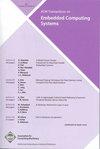obnoc:保护片上网络结构免受逆向工程攻击
IF 2.6
3区 计算机科学
Q2 COMPUTER SCIENCE, HARDWARE & ARCHITECTURE
引用次数: 0
摘要
现代片上系统设计通常使用片上网络(NoC)结构来实现集成硬件块之间的协调。一类重要的安全漏洞涉及恶意铸造厂对NoC拓扑和路由逻辑进行逆向工程。在本文中,我们开发了一个基础设施obnoc,用于保护NoC结构免受此类攻击。obnoc系统地用交换机取代路由器连接,这些交换机可以在制造后编程以诱导所需的拓扑结构。我们的方法提供了可证明的NoC功能编校:交换机配置导致大量合法拓扑,其中只有一个与预期拓扑对应。我们在Intel Quartus™平台上实现了obnoc方法,实际SoC设计的实验结果表明,该架构在功耗、资源利用率和系统延迟方面的开销最小。本文章由计算机程序翻译,如有差异,请以英文原文为准。
Modern System-on-Chip designs typically use Network-on-Chip (NoC) fabrics to implement coordination among integrated hardware blocks. An important class of security vulnerabilities involves a rogue foundry reverse-engineering the NoC topology and routing logic. In this paper, we develop an infrastructure, ObNoCs , for protecting NoC fabrics against such attacks. ObNoCs systematically replaces router connections with switches that can be programmed after fabrication to induce the desired topology. Our approach provides provable redaction of NoC functionality: switch configurations induce a large number of legal topologies, only one of which corresponds to the intended topology. We implement the ObNoCs methodology on Intel Quartus™ Platform, and experimental results on realistic SoC designs show that the architecture incurs minimal overhead in power, resource utilization, and system latency.
求助全文
通过发布文献求助,成功后即可免费获取论文全文。
去求助
来源期刊

ACM Transactions on Embedded Computing Systems
工程技术-计算机:软件工程
CiteScore
3.70
自引率
0.00%
发文量
138
审稿时长
6 months
期刊介绍:
The design of embedded computing systems, both the software and hardware, increasingly relies on sophisticated algorithms, analytical models, and methodologies. ACM Transactions on Embedded Computing Systems (TECS) aims to present the leading work relating to the analysis, design, behavior, and experience with embedded computing systems.
 求助内容:
求助内容: 应助结果提醒方式:
应助结果提醒方式:


